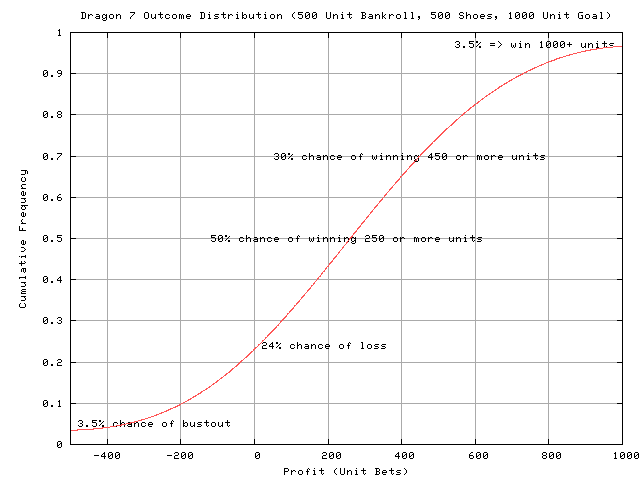Two-Person Panda-8 Co-Count
 There are times when you’re at a casino with a friend, and you want to count the EZ-Baccarat Dragon-7. Normally, it’s kind of boring, and you certainly don’t need two people to do it. While it’s a good advantage play, it’d be better and a lot more fun if your friend could help with the Panda-8. I’ve posted a very complicated Panda-8 count that yields about 22% of a fixed bet per shoe. I’ve also posted a super-simple Panda-8 co-count that only yields about 9% of a fixed bet per shoe, but is meant as a single-person add-on to the Dragon-7 count.
There are times when you’re at a casino with a friend, and you want to count the EZ-Baccarat Dragon-7. Normally, it’s kind of boring, and you certainly don’t need two people to do it. While it’s a good advantage play, it’d be better and a lot more fun if your friend could help with the Panda-8. I’ve posted a very complicated Panda-8 count that yields about 22% of a fixed bet per shoe. I’ve also posted a super-simple Panda-8 co-count that only yields about 9% of a fixed bet per shoe, but is meant as a single-person add-on to the Dragon-7 count.
In this post, I’ve worked out a better Panda-8 co-count that can be easily tracked by a second person. You add its running count to the Dragon-7 RC to determine when to bet the Panda. The idea exploits the common values between the two counts, resulting in a simple Panda-8 co-count. I worked this out, because I plan to use it.
Here’s the taps for the Panda-8 co-count. You add its running count to the unbalanced Dragon-7 running count, and bet when the total count is +35 or higher. You’ll get about +13.4% of a fixed bet per shoe, on an average of 3.6 bets per shoe.
| Rank | Count |
|---|---|
| Six, Seven, King, Queen | +1 |
| Trey | -1 |
| Eight | -3 |
| Rank | Count |
|---|---|
| Four, Five, Six, Seven | -1 |
| Eight, Nine | +2 |
| Ace | +1 |
Unbalanced Dragon 7 Count
 If you’re ever at an EZ-Baccarat table wondering how to properly count the Dragon-7, here’s an easy-to-use unbalanced count that you won’t forget. Unbalanced counts are very handy, because their running counts (RC) approximate true counts, without any division. They’re a nice little trick that everyone should use. I modified the count from my Dragon-7 tracking sheet post into the unbalanced count below.
If you’re ever at an EZ-Baccarat table wondering how to properly count the Dragon-7, here’s an easy-to-use unbalanced count that you won’t forget. Unbalanced counts are very handy, because their running counts (RC) approximate true counts, without any division. They’re a nice little trick that everyone should use. I modified the count from my Dragon-7 tracking sheet post into the unbalanced count below.
You simply start the count at -32 for a new shoe, then update the running count for each card dealt, including the exposed burn card. When the running count is > 0, bet the Dragon-7 side bet. This count scheme simulates at a profit rate of +52% of a fixed bet per 8-deck shoe, when 16 cards are placed behind the cut card. You’ll get about 6.8 betting opportunities per shoe.
| Card Rank | Count Value |
|---|---|
| Ten/Face | 0 |
| Ace | +1 |
| Deuce | 0 |
| Trey | 0 |
| Four | -1 |
| Five | -1 |
| Six | -1 |
| Seven | -1 |
| Eight | +2 |
| Nine | +2 |
The variance of the bet is very high, and unless you’re heads-up with the dealer, the hand rate is very slow. If you’re wondering if you can grind out a profit from the bet, look at the outcome distribution below for a 500 unit bankroll with a +1000 unit goal, else playing for 500 shoes. While the risk of ruin is only 3.5%, you still have a 24% chance of losing after 500 shoes. Your average win is +250 units. So, if you have a $50k bankroll, can find a heads-up EZ-Baccarat table with a $100 max Dragon-7 bet, are committed to playing for hundreds of hours, and don’t draw any suspicion from casino personnel, then you can win from $50 to $100 per hour, depending on how fast you play. It might be fun for the first hour or two, but only if you hit a dragon. Try playing my Dragon-7 shoe simulator before you head out to the casino.

Dragon-7 Shoe Simulator
Click on the screenshot below to run my shoe-by-shoe simulator for counting the EZ-Baccarat Dragon-7 side bet:
I’ve been playing the EZ-Baccarat lately, because it’s really easy to count for the 40-to-1 Dragon-7 side bet, and it gets pretty exciting when you’re betting for big payouts at the end of a shoe (each $10 pays out $400). I’m still a baccarat newbie, but I’m starting to appreciate the drama of the game. Most people record notation of the hands, and they all study the hand history displayed on the monitor. They’re looking for long runs of Banker or Player wins. On a Banker run, they increase their bets, and everyone makes a lot of money, and all are happy. When the Player is on a winning run, they wait until they think it’s impossible for the Player to win yet another hand. Then they bet big on the Banker. If the Player wins again, everyone is outraged, and they bet even more to win back their money. It gets pretty dramatic, especially when the Player wins yet again. People don’t think like this on blackjack, probably because there’s no hand history display, and because you can’t bet on the dealer. Baccarat is a very dangerous game that feeds off of people’s natural instincts to see patterns in nature.
Anyways, I don’t care at all about Player/Banker, I’m just tracking the Dragon-7 count, and waiting for the opportunity to bet it. Mostly, this comes at the end of the shoe, so I make minimum Player or Banker bets just to feel a part of the table. Overall, betting $10 Banker/Player every hand will cost an average $8/shoe. I make $10+ dragon bets when the count is good, so I’ll win back at least $5.30/shoe of that on average. Overall, it’s very cheap entertainment.
I use the baccarat recording cards provided by the casino to track the dragon. Everyone uses the cards in Landscape orientation, and draws red and blue circles. I turn the card 90° and write down the +/- running count for each hand. I use the unbalanced Dragon-7 count, starting the RC at -32, and updating it for every card seen, including the burn. When the RC is greater than 0, I bet the dragon on the next hand.
My Flash game simulates one shoe at a time, showing the unbalanced running count (RC) that I record on the baccarat cards. I indicate the outcome of +EV dragon bets with green for wins, and red for losses. When a dragon occurs while not betting, I note the “miss” in yellow. For example, in the screenshot above, 83 hands were played in the shoe, and 3 dragons hit (hands #41, #67, and #69). The count wasn’t good enough to bet on the first dragon, which we missed (yellow). The RC was > 0 for almost all of the hands from #61 – #75. We hit the dragon on hand #67 when the count was +7, and on hand #69 when the count was +8.
Play around with the simulator if you’re thinking about trying to make a profit at the bet. While it’s probably the best +EV game you’ll ever find (easiest to implement, and most average profit per shoe), the game is very slow at a full table. In order to try to make money, you’d need to get heads up with a dealer, which can yield up to 3 shoes an hour (optimal). Needless to say, the swings are huge, due to the nature of the 40-to-1 payout. However, (2 shoes/hr)($100 dragon bets)(0.53 profit/shoe) = $100 profit/hr looks pretty attractive.
Baccarat Dragon-7 Tracking Sheet
 Update: See the tracking sheet in action with my Dragon-7 shoe-by-shoe simulator. Also, check out the much easier-to-use unbalanced Dragon-7 count.
Update: See the tracking sheet in action with my Dragon-7 shoe-by-shoe simulator. Also, check out the much easier-to-use unbalanced Dragon-7 count.
I tested out Eliot Jacobson’s true count system for the 40-to-1 baccarat dragon-7 bet (banker wins with 3 card 7), and got excellent results with the following tracking sheet:
![]()
The sheet helps you track the running count (RC) for each hand in the shoe. You just compare the running count (RC) to the minimum betting threshold for the next hand. When the RC is greater or equal to the number printed in next box, bet the dragon.
The tracking sheet simulates at an average profit of about $53 per shoe, for $100 dragon bets. On average, you’ll make about 5.2 dragon bets per shoe.
I put together this tracking sheet because I know no one is going to read the WoO post and implement the true count correctly at the table. Half the people around the baccarat table write down something complicated every hand, so this will be my craziness.
Instructions
Use the following count values for each card:
| Card | Count Value |
|---|---|
| Ace | 0 (ignore) |
| Deuce | 0 (ignore) |
| Trey | 0 (ignore) |
| Four | -1 |
| Five | -1 |
| Six | -1 |
| Seven | -1 |
| Eight | 2 |
| Nine | 2 |
| Face/Ten | 0 (ignore) |
The dealer pulls the first card out of the shoe, and turns it face up. Start the running count with the count value of the card. The following unseen burn cards do not affect the RC or the bet thresholds.
For each hand dealt, add up the count values of each card to get the count for the hand. Notice that 8’s and 9’s are +2, and 4-thru-7’s are -1. Ignore all other cards. Write down the count for the hand in the sub-box, and add it to the running count (RC). Write the new RC value in the box.
If the new RC is greater or equal to the number printed in the next hand’s box, then bet the dragon. That’s it.
Examples
You’re at the start of the shoe. The dealer pulls out a 7, and burns seven cards. Start the running count at -1.
The first hand dealt is player (10,9) and banker (4,5). The count value of this hand is 2-1-1 = 0. The RC doesn’t change, so write the RC of -1 in the box. The RC of -1 is less than the minimum 40 required to bet the dragon on the next hand.
The next hand dealt is player (1,2) and banker (8,10). The count value of the hand is +2. Write the new running count of +1 in the box. Again, the RC of +1 is too low to bet the dragon on the next hand (need at least 40).
Keep filling in the hand boxes, from left to right, and down the page. There are about 80.9 hands/shoe on average. There’s room for 88 hands, which occurs very infrequently. You can track two shoes per sheet. You’ll see as you get deeper into the shoe, the minimum RC for betting the dragon decreases. This follows from true count = RC/(decks remaining).

5 comments